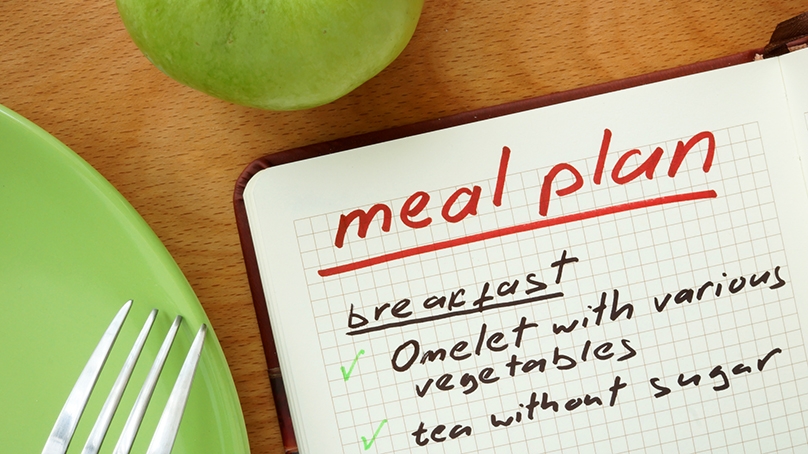Combat the Nightly "Whats for Dinner?" Stress
September 16, 2019 | Food Lion



Combat the Nightly "Whats for Dinner?" Stress
Have you ever had a crazy long day and walked in the door hungry, but without a clue what to do for dinner? Have you ever spent an hour thinking about what you should make only to end up ordering take out or microwaving a frozen meal?
Life is busy and, without some basic organization and planning, eating healthy can sometimes feel like a chore.
Weekly meal planning and bulk food prepping are two popular concepts getting a lot of buzz these days. The concept is simple: if you have a plan, a fully stocked fridge and a couple key items prepared in advance, you can pull together a nutritious homemade meal in less than 10 minutes. Sounds like magic, right?
Well, it's not, and here's how to make it happen.
Planning
Before heading to the supermarket, create your weekly meal plan, listing all recipe ingredients. Take inventory of what you have on hand in your pantry versus what you need. Here are some tips to make your meal planning successful:
- Having a plan does not mean you have to stick to it exactly. A plan is supposed to give you go-to options so, during your busy week, you don't have to stop and think about meals.
- Build in a break night or two to avoid burnout. Look at your weekly schedule and see what days you're busiest where a break would make sense for you. For your break night, you can plan for leftovers (double the serving size another night) or even dine out.
- If you're a dessert person, make sure you plan that out too. Find some healthy dessert recipes online and make that part of your plan. And always store your favorite cut-up fruit in your refrigerator for easy access to a refreshing, sweet treat.
- Make one extra large batch of soup, stew or chili each week to freeze for leftovers the following week—they freeze well and are filling if you add protein and grains in addition to vegetables.
- Seek help from your family with pulling the meals together or cleaning up. If everyone pitches in it won't be so much work.
- Variety is key for success. Plan for different types of dishes and flavors throughout the week so you don't get bored and go off track. For example, if one night you have a soup and salad, plan for something such as a stir-fry, grain bowl or pasta the next night. Also, if you cook Italian one night, try for some Middle Eastern spices the next. Be sure to vary your meal plan week to week as well. Vegetables change seasonally so shop for local produce. Farmers markets are great options.
Shopping
Before weekly shopping begins, make sure your pantry is stocked with these basics:
- Grains such as brown rice, quinoa, soft whole-grain wraps and whole-grain pasta
- Proteins such as chickpeas, split peas, lentils (red and green), nuts (almonds, walnuts, pecans, cashews), seeds (sunflower, pumpkin, hemp) and beans (black beans, white beans)
- Oils (olive, avocado, sesame, canola), vinegars (balsamic, white wine), broths, canned tomatoes, tahini and nut or seed butters
- Long lasting vegetables like onions, potatoes and sweet potatoes
- Flavor enhancers such as lemons, limes, maple syrup, garlic, dried fruit, ginger and dried seasonings
With these staples on hand, your weekly grocery list won't be so overwhelming. Shop once a week with your prepared list and stick to it. Try not to get distracted by items not in your weekly meal plan. This will save you time and money.
PREPPING
Investing a little time on the weekend will set you up for a healthy week ahead. You do not have to prep everything in advance, though. Prep a few basics that can be worked into versatile meals throughout the week. You can make it fun and involve others, or even just listen to music or an audio book while you chop and prep. To start, get your kitchen clear and clean, preheat the oven, and grab a cutting board.
Here are some things that can be made in advance to make pulling together dinner a breeze:
1. Make dressings and sauces in advance
Make some basic sauces and/or dressings that can be used throughout the week by tweaking from meal to meal. The same sauce used for a grain bowl on Monday can be enhanced with more spices and thinned out with vinegar and/or olive oil for a salad entree on Tuesday. Dressings and sauces typically last about a week in the refrigerator.
2. Prep & Roast Vegetables
Roasting vegetables all at once ensures you will get vegetables at every meal throughout the week. You can toss them into salads, grain bowls or pasta—or serve on the side. Use large, rimmed sheet pans lined with parchment paper and roast all your vegetables at once. Group similar ones together so you can pull them out at different times.
For example, hard vegetables such as squash, potatoes, sweet potatoes, carrots and beets should be separate from more delicate, fast-cooking vegetables such as bell peppers, mushrooms, tomatoes, broccoli and asparagus.
Dice vegetables similarly in size so they can cook at the same speed. Roast at a temperature between 375 to 400 degrees until they are golden brown. Keep in mind that a fuller oven may take longer. Give your vegetables basic flavor by tossing with olive oil, salt and pepper. Throughout the week you can add sauces or additional seasonings to flavor them differently.
You can also roast chickpeas during this time. They are a great addition to salads, soups and grain bowls for added plant-based protein and fiber. To make, coat chickpeas lightly with olive oil, salt, pepper and your favorite spices. Bake at 400 degrees on a large rimmed baking sheet lined with parchment paper for 30-35 minutes until golden and lightly charred. Toss them once halfway through.
Not all vegetables need to be roasted. You can chop radishes, cucumbers, green onions and red onions in advance to toss into salads and grain bowls. Shred carrots in a food processor for stir-fries, soups and salads throughout the week. Kale is the optimal leafy green for meal prep. You can wash, dry and chop a large bunch and use throughout the week in salads, soups and stir-fries. Kale holds up well even when coated in dressing. It won't get soggy as quickly as romaine or other leafy greens, so it makes for great leftovers.







Create Your Display Name